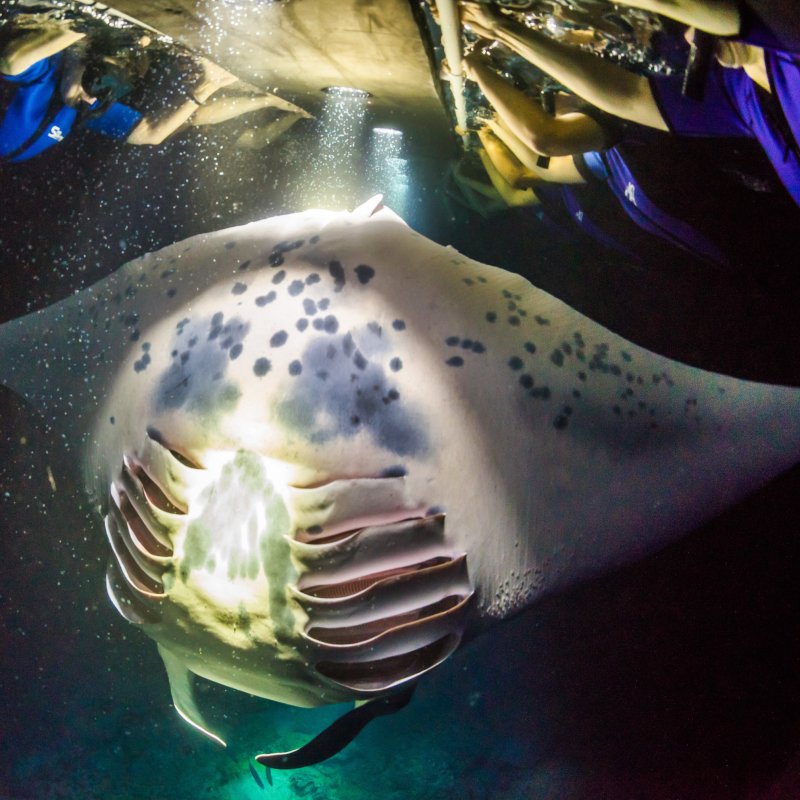
The Big Island of Hawaii is a mystical, magical place. One of the excursions that took our visit absolutely over the top was an evening snorkel with giant manta rays. It was an incredible outing that we would do again in an instant. Here’s what you need to know to prepare for an underwater adventure with these amazing creatures. It’s an experience you’ll never forget!
Videos by TravelAwaits

1. Get A Great Tour Provider
As with most tours, choosing a well-reviewed and recommended provider is of the utmost importance. An evening open-ocean snorkel can be intimidating, and you’ll want to make sure you’re with an experienced, knowledgeable crew who knows where the mantas come to feed and can easily talk you through every step of the experience. We chose SeaQuest out of Kona, and they did not disappoint. They met us at Keauhou Bay and explained every step of the process that would unfold that evening.
They were patient, helped us get to the viewing raft, and took great care to answer all the questions we had. They also know these animals well and were just as excited as we were to see them emerge from the deep and circle below us. Our crew had hot chocolate and cookies waiting for us after the snorkel, which was a much-appreciated perk!
2. Choose Your Gear Carefully
On the dock, our SeaQuest crew gave us wetsuits as the evening ocean water can get a bit chilly. You’ll want to make sure they’re snug and not saggy so you don’t get weighed down out in the water. Once on board our boat, we were offered standard snorkel gear. However, we opted to bring our own full-face Tribord masks. I’m not a big fan of breathing through my mouth, and these masks make all the difference! They fit over your entire face, giving you a better underwater view and allowing you to breathe normally. We were able to really relax with these masks, which made our experience that much better.

3. You Will Swim Quite A Bit
As the sun was going down, our boat took us out past the mouth of the bay to a spot where the mantas are known to feed at night. Once there, the crew deployed a raft outfitted with a spotlight that shone down into the water. The light attracts plankton, which the manta love to eat. We then had to swim out to the raft through some light ocean chop — about 20 yards. We used pool noodles as floatation devices for the swim and to keep us afloat during the snorkel. Once at the raft, we were instructed to grab its sides, keep our faces down in the water, and keep our bodies stretched out behind us. Then we watched and waited as the plankton swarmed below.

4. You Won’t Believe Your Eyes
After about 10 minutes, we saw an enormous shadowy figure approach. Its wingspan was easily 12 feet across. Suddenly, it was right under us, somersaulting through the water just below as it fed on the plankton. As this gentle giant swooped and flipped just inches from us, we watched in amazement as two more rays joined in the feed. These gorgeous creatures were so incredible — and so close. It was all we could do not to shriek with excitement as we saw the mantas approach. We were absolutely awestruck by their beauty and grace and couldn’t believe our great luck that we got to see three of them during our snorkel.
5. You’ll Need To Go With the Flow
Our guides were quick to point out that seeing three mantas right under the raft was a rare occurrence. Some evenings the mantas will be very social; other evenings, they might keep their distance. They might also keep you waiting a bit. We went in with the mindset that we’d be happy just to see a single manta ray.
Our crew was quite up to date with the manta sighting patterns in Keauhou Bay that week and knew the exact spot to stop for our excursion. These experts made the experience fun and easy, but it also helped that we had low expectations that were greatly exceeded by our fantastic encounter!
6. Do Not Touch
This is essential to keep in mind. These animals are a protected species, and for all their great size and strength, they are actually quite fragile. Our guides explained that a touch from us could expose the animals to bacteria or other pathogens that could make them sick. While they did come so close we were nudged twice, there is a strict hands-off policy. If at any time we were seen trying to touch the animals, we would have been immediately escorted back to the boat. So, keep your hands to yourself and let the mantas eat in peace!

7. Don’t Panic!
Let’s be honest: It is kind of freaky to be in the open ocean after dark, peering down into the depths while you are waiting for enormous 1,000-pound creatures to come swimming at you — and under you. Don’t lose your cool. Keep your breathing in check while you’re waiting, be confident that you have a knowledgeable crew around you, and once the rays do show up, keep in mind that they are toothless. They use tiny plates in their mouths to strain plankton from the water. You are much more dangerous to them than they are to you.
8. To Document, Or Not To Document?
Many of us have a tendency to want to document our trip’s big moments with selfies, quick snaps, or videos. We decided that we wanted to be fully present for this experience and not worry about a tech disaster if we dropped a phone or underwater camera. Some tour operators will take their own photos of your experience and offer them at an extra cost. Consider this option to free yourself up fully for your snorkel.
Trust us, you won’t want to take your eyes off the mantas once they appear, and the last thing you’ll want to do is fumble for a camera!
Learn how to do Hawaii’s Big Island in one day or, if you’re captivated by manta rays, read about one traveler’s volunteer trip to Africa, where she helped further manta research off the coast of Mozambique.

